Phosphorus Loss Risk in the Ju River Basin, China, Under Urbanization and Climate Change: Insights from the Hydrological Simulation Program—FORTRAN (HSPF) Model
Abstract
1. Introduction
2. Materials and Methods
2.1. Study Areas
2.2. Data Collection and Processing
2.3. Model Calibration and Validation
2.4. Scenario Design
3. Results
3.1. Impact of Urban Expansion on River Discharge
3.2. Impact of Urban Expansion on Total Phosphorus Concentration
3.3. Impact of Increased Precipitation on River Discharge
3.4. Impact of Increased Precipitation on Total Phosphorus Concentration
3.5. Variations in Phosphorus Loads Under Different Scenarios
4. Discussion
4.1. Amplifying Effects of Urbanization on Extreme Hydrological Responses
4.2. Agricultural Dominance and Temporal Shifts in Phosphorus Sources
4.3. Broader Implications for Eutrophication Control in Small Catchments
4.4. Impacts on Downstream Ecosystems
4.5. Limitations and Future Research Directions
5. Conclusions
Supplementary Materials
Author Contributions
Funding
Data Availability Statement
Acknowledgments
Conflicts of Interest
References
- MacDonald, G.K.; Bennett, E.M.; Potter, P.A.; Ramankutty, N. Agronomic phosphorus imbalances across the world’s croplands. Proc. Natl. Acad. Sci. USA 2011, 108, 3086–3091. [Google Scholar] [CrossRef]
- Sharpley, A.N.; Bergström, L.; Aronsson, H.; Bechmann, M.; Bolster, C.H.; Börling, K.; Djodjic, F.; Jarvie, H.P.; Schoumans, O.F.; Stamm, C.; et al. Future agriculture with minimized phosphorus losses to waters: Research needs and direction. Ambio 2015, 44, 163–179. [Google Scholar] [CrossRef]
- Veneklaas, E.J.; Lambers, H.; Bragg, J.; Finnegan, P.M.; Lovelock, C.E.; Plaxton, W.C.; Price, C.A.; Scheible, W.-R.; Shane, M.W.; White, P.J.; et al. Opportunities for improving phosphorus-use efficiency in crop plants. New Phytol. 2012, 195, 306–320. [Google Scholar] [CrossRef]
- Hartmann, J.; Moosdorf, N.; Lauerwald, R.; Hinderer, M.; West, A.J. Global chemical weathering and associated P-release—The role of lithology, temperature and soil properties. Chem. Geol. 2014, 363, 145–163. [Google Scholar] [CrossRef]
- Filippelli, G.M. The global phosphorus cycle: Past, present, and future. Elements 2008, 4, 89–95. [Google Scholar] [CrossRef]
- FAO. FAO World Fertilizer Trends and Outlook to 2022. FAO: Rome, Italy, 2020. [Google Scholar] [CrossRef]
- Withers, P.J.; Neal, C.; Jarvie, H.P.; Doody, D.G. Agriculture and eutrophication: Where do we go from here? Sustainability 2014, 6, 5853–5875. [Google Scholar] [CrossRef]
- Tipping, E.; Benham, S.; Boyle, J.F.; Crow, P.; Davies, J.; Fischer, U.; Guyatt, H.; Helliwell, R.; Jackson-Blake, L.; Lawlor, A.J.; et al. Atmospheric deposition of phosphorus to land and freshwater. Environ. Sci. Process. Impacts 2014, 16, 1608–1617. [Google Scholar] [CrossRef] [PubMed]
- Hao, L.; Sun, G.; Liu, Y.; Wan, J.; Qin, M.; Qian, H.; Liu, C.; Zheng, J.; John, R.; Fan, P.; et al. Urbanization dramatically altered the water balances of a paddy field-dominated basin in southern China. Hydrol. Earth Syst. Sci. 2015, 19, 3319–3331. [Google Scholar] [CrossRef]
- Sharpley, A.N.; Kleinman, P.J.; McDowell, R.W.; Gitau, M.; Bryant, R.B. Modeling phosphorus transport in agricultural watersheds: Processes and possibilities. J. Soil Water Conserv. 2002, 57, 425–439. [Google Scholar] [CrossRef]
- Wu, H.; Jiao, X.; Wang, Y.; Wang, M.; Zhou, J.; Wu, K.; Chen, D. Influence of climate and land use on watershed anthropogenic phosphorus inputs and riverine phosphorus export dynamics: A global analysis. Sci. Total Environ. 2024, 933, 172991. [Google Scholar] [CrossRef]
- Bian, Z.; Pan, S.; Wang, Z.; Yao, Y.; Xu, R.; Shi, H.; Kalin, L.; Anderson, C.; Justic, D.; Lohrenz, S.; et al. A century-long trajectory of phosphorus loading and export from Mississippi River Basin to the Gulf of Mexico: Contributions of multiple environmental changes. Glob. Biogeochem. Cycles 2022, 36, e2022GB007347. [Google Scholar] [CrossRef]
- Yin, S.; Gao, G.; Li, Y.; Xu, Y.J.; Turner, R.E.; Ran, L.; Wang, X.; Fu, B. Long-term trends of streamflow, sediment load and nutrient fluxes from the Mississippi River Basin: Impacts of climate change and human activities. J. Hydrol. 2023, 616, 128822. [Google Scholar] [CrossRef]
- Lucas, E.; Kennedy, B.; Roswall, T.; Burgis, C.; Toor, G.S. Climate change effects on phosphorus loss from agricultural land to water: A review. Curr. Pollut. Rep. 2023, 9, 623–645. [Google Scholar] [CrossRef]
- Menge, D.N.; Kou-Giesbrecht, S.; Taylor, B.N.; Akana, P.R.; Butler, A.; Carreras Pereira, K.A.; Cooley, S.S.; Lau, V.M.; Lauterbach, E.L. Terrestrial phosphorus cycling: Responses to climatic change. Annu. Rev. Ecol. Evol. Syst. 2023, 54, 429–449. [Google Scholar] [CrossRef]
- Jarvie, H.P.; Sharpley, A.N.; Spears, B.; Buda, A.R.; May, L.; Kleinman, P.J. Water quality remediation faces unprecedented challenges from “legacy phosphorus”. ACS Publ. 2013, 47, 8991–8998. [Google Scholar] [CrossRef]
- Kang, L.; Zhu, G.; Zhu, M.; Xu, H.; Zou, W.; Xiao, M.; Zhang, Y.; Qin, B. Bloom-induced internal release controlling phosphorus dynamics in large shallow eutrophic Lake Taihu, China. Environ. Res. 2023, 231, 116251. [Google Scholar] [CrossRef]
- Tao, Y.; Dan, D.; Xuejiao, H.; Changda, H.; Guo, F.; Fengchang, W. Characterization of phosphorus accumulation and release using diffusive gradients in thin films (DGT)-linking the watershed to Taihu Lake China. Sci. Total Environ. 2019, 673, 347–356. [Google Scholar] [CrossRef]
- Dupas, R.; Delmas, M.; Dorioz, J.-M.; Garnier, J.; Moatar, F.; Gascuel-Odoux, C. Assessing the impact of agricultural pressures on N and P loads and eutrophication risk. Ecol. Indic. 2015, 48, 396–407. [Google Scholar] [CrossRef]
- Khan, S.; Wang, Y.; Milham, P.J.; Lin, Z.; Qi, X.; Gao, H.; Duan, Y.; Shi, J.; Oduro, C.; Ullah, H.; et al. Effect of stormwater and land use on biogeochemical transformations of dissolved and particulate phosphorus in freshwater systems. Water Res. 2025, 284, 124007. [Google Scholar] [CrossRef] [PubMed]
- Tang, H.; Wang, Z.; Tang, B.; Ma, Y.; Pei, L.; Tian, F.; Wang, J.; Nanding, N.; Sparrow, S.; Tett, S.; et al. Reduced probability of 2020 June–July persistent heavy Meiyu rainfall event in the mid-lower reaches of the Yangtze River basin under anthropogenic forcing. Bull. Am. Meteorol. Soc. 2022, 103, 83–89. [Google Scholar] [CrossRef]
- Zhou, S.; Williams, A.P.; Berg, A.M.; Cook, B.I.; Zhang, Y.; Hagemann, S.; Lorenz, R.; Seneviratne, S.I.; Gentine, P. Land–atmosphere feedbacks exacerbate concurrent soil drought and atmospheric aridity. Proc. Natl. Acad. Sci. USA 2019, 116, 18848–18853. [Google Scholar] [CrossRef]
- GB 11893-89; Water Quality-Determination of Total Phosphorus-Ammonium Molybdate Spectrophotometric Method. State Administration for Market Regulation: Beijing, China, 1989.
- Lin, Z. Estimating Water Budgets and Vertical Leakages for Karst Lakes in North-Central Florida (United States) Via Hydrological Modeling 1. J. Am. Water Resour. Assoc. 2011, 47, 287–302. [Google Scholar] [CrossRef]
- Liu, Z.; Tong, S.T.Y. Using HSPF to Model the Hydrologic and Water Quality Impacts of Riparian Land-Use Change in a Small Watershed. J. Environ. Inform. 2011, 17, 15–24. [Google Scholar] [CrossRef]
- Jacobson, C.R. Identification and quantification of the hydrological impacts of imperviousness in urban catchments: A review. J. Environ. Manag. 2011, 92, 1438–1448. [Google Scholar] [CrossRef]
- Wang, Z.; Zhang, S.; Peng, Y.; Wu, C.; Lv, Y.; Xiao, K.; Zhao, J.; Qian, G. Impact of rapid urbanization on the threshold effect in the relationship between impervious surfaces and water quality in shanghai China. Environ. Pollut. 2020, 267, 115569. [Google Scholar] [CrossRef] [PubMed]
- Yang, L.; Smith, J.A.; Baeck, M.L.; Zhang, Y. Flash flooding in small urban watersheds: Storm event hydrologic response. Water Resour. Res. 2016, 52, 4571–4589. [Google Scholar] [CrossRef]
- Zhou, Z.; Smith, J.A.; Baeck, M.L.; Wright, D.B.; Smith, B.K.; Liu, S. The impact of spatiotemporal structure of rainfall on flood frequency over a small urban watershed: An approach coupling stochastic storm transposition and hydrologic modeling. Hydrol. Earth Syst. Sci. Discuss. 2021, 2021, 4701–4717. [Google Scholar] [CrossRef]
- Feng, B.; Zhang, Y.; Bourke, R. Urbanization impacts on flood risks based on urban growth data and coupled flood models. Nat. Hazards 2021, 106, 613–627. [Google Scholar] [CrossRef]
- Alamdari, N.; Hogue, T.S. Assessing the effects of climate change on urban watersheds: A review and call for future research. Environ. Rev. 2022, 30, 61–71. [Google Scholar] [CrossRef]
- Weng, Q. Remote sensing of impervious surfaces in the urban areas: Requirements, methods, and trends. Remote Sens. Environ. 2012, 117, 34–49. [Google Scholar] [CrossRef]
- Osterholz, W.R.; Hanrahan, B.R.; King, K.W. Legacy phosphorus concentration–discharge relationships in surface runoff and tile drainage from Ohio crop fields. J. Environ. Qual. 2020, 49, 675–687. [Google Scholar] [CrossRef]
- Stackpoole, S.M.; Stets, E.G.; Sprague, L.A. Variable impacts of contemporary versus legacy agricultural phosphorus on US river water quality. Proc. Natl. Acad. Sci. USA 2019, 116, 20562–20567. [Google Scholar] [CrossRef] [PubMed]
- Tilahun, A.B.; Dürr, H.H.; Schweden, K.; Flörke, M. Perspectives on total phosphorus response in rivers: Examining the influence of rainfall extremes and post-dry rainfall. Sci. Total Environ. 2024, 940, 173677. [Google Scholar] [CrossRef]
- Liu, J.; Han, C.; Zhao, Y.; Yang, J.; Cade-Menun, B.J.; Hu, Y.; Li, J.; Liu, H.; Sui, P.; Chen, Y.; et al. The chemical nature of soil phosphorus in response to long-term fertilization practices: Implications for sustainable phosphorus management. J. Clean. Prod. 2020, 272, 123093. [Google Scholar] [CrossRef]
- Wang, J.; Qi, Z.; Wang, C. Phosphorus loss management and crop yields: A global meta-analysis. Agric. Ecosyst. Environ. 2023, 357, 108683. [Google Scholar] [CrossRef]
- Deng, C.; Xiong, Q.; Harrison, M.T.; Xu, F.; Xiang, Q.; Li, L.; Liu, K. Declining frequency yet increasing intensity of crop waterlogging events under future climates. J. Hydrol. 2025, 663, 134178. [Google Scholar] [CrossRef]
- Bai, Z.; Liu, L.; Kroeze, C.; Strokal, M.; Chen, X.; Yuan, Z.; Ma, L. Optimizing phosphorus fertilizer use to enhance water quality, food security and social equality. Resour. Conserv. Recycl. 2024, 203, 107400. [Google Scholar] [CrossRef]
- Xia, Y.; Zhang, M.; Tsang, D.C.; Geng, N.; Lu, D.; Zhu, L.; Igalavithana, A.D.; Dissanayake, P.D.; Rinklebe, J.; Yang, X. Recent advances in control technologies for non-point source pollution with nitrogen and phosphorous from agricultural runoff: Current practices and future prospects. Appl. Biol. Chem. 2020, 63, 8. [Google Scholar] [CrossRef]
- Yang, Y.-Y.; Toor, G.S. Sources and mechanisms of nitrate and orthophosphate transport in urban stormwater runoff from residential catchments. Water Res. 2017, 112, 176–184. [Google Scholar] [CrossRef] [PubMed]
- Yang, Y.-Y.; Toor, G.S. Stormwater runoff driven phosphorus transport in an urban residential catchment: Implications for protecting water quality in urban watersheds. Sci. Rep. 2018, 8, 11681. [Google Scholar] [CrossRef] [PubMed]
- Whitehead, P.G.; Wilby, R.L.; Battarbee, R.W.; Kernan, M.; Wade, A.J. A review of the potential impacts of climate change on surface water quality. Hydrol. Sci. J. 2009, 54, 101–123. [Google Scholar] [CrossRef]
- Sudriani, Y.; Sebestyén, V.; Abonyi, J. Surface water monitoring systems—The importance of integrating information sources for sustainable watershed management. IEEE Access 2023, 11, 36421–36451. [Google Scholar] [CrossRef]
- Sharma-Wallace, L.; Velarde, S.J.; Wreford, A. Adaptive governance good practice: Show me the evidence! J. Environ. Manag. 2018, 222, 174–184. [Google Scholar] [CrossRef]
- Chaffin, B.C.; Garmestani, A.S.; Gunderson, L.H.; Benson, M.H.; Angeler, D.G.; Arnold, C.A.; Cosens, B.; Craig, R.K.; Ruhl, J.B.; Allen, C.R. Transformative environmental governance. Annu. Rev. Environ. Resour. 2016, 41, 399–423. [Google Scholar] [CrossRef]
- Amorim, C.A.; do Nascimento Moura, A. Ecological impacts of freshwater algal blooms on water quality, plankton biodiversity, structure, and ecosystem functioning. Sci. Total Environ. 2021, 758, 143605. [Google Scholar] [CrossRef]
- Boubacar, I.; Pindilli, E.; Brown, E.; Simon, B.; Skrabis, K.; Luby, I. Societal Benefits of Cyanobacteria Harmful Algal Bloom Management in Lake Okeechobee in Florida—Potential Damages Avoided During the 2018 Event Under US Army Corps of Engineers Harmful Algal Bloom Interception, Treatment, and Transformation System Scenarios; No. 2024-5091; US Geological Survey: Reston, VA, USA, 2024.
- Wang, C.; Huang, C.; Zhang, S.; Zhang, L.; Li, T.; Peng, J.; Zhang, L. Research Progress on Nitrogen and Phosphorus Loss in Small Watersheds: A Regional Review. Water 2023, 15, 2894. [Google Scholar] [CrossRef]
- Paerl, H.W.; Scott, J.T.; McCarthy, M.J.; Newell, S.E.; Gardner, W.S.; Havens, K.E.; Hoffman, D.K.; Wilhelm, S.W.; Wurtsbaugh, W.A. It takes two to tango: When and where dual nutrient (N & P) reductions are needed to protect lakes and downstream ecosystems. Environ. Sci. Technol. 2016, 50, 10805–10813. [Google Scholar] [CrossRef] [PubMed]
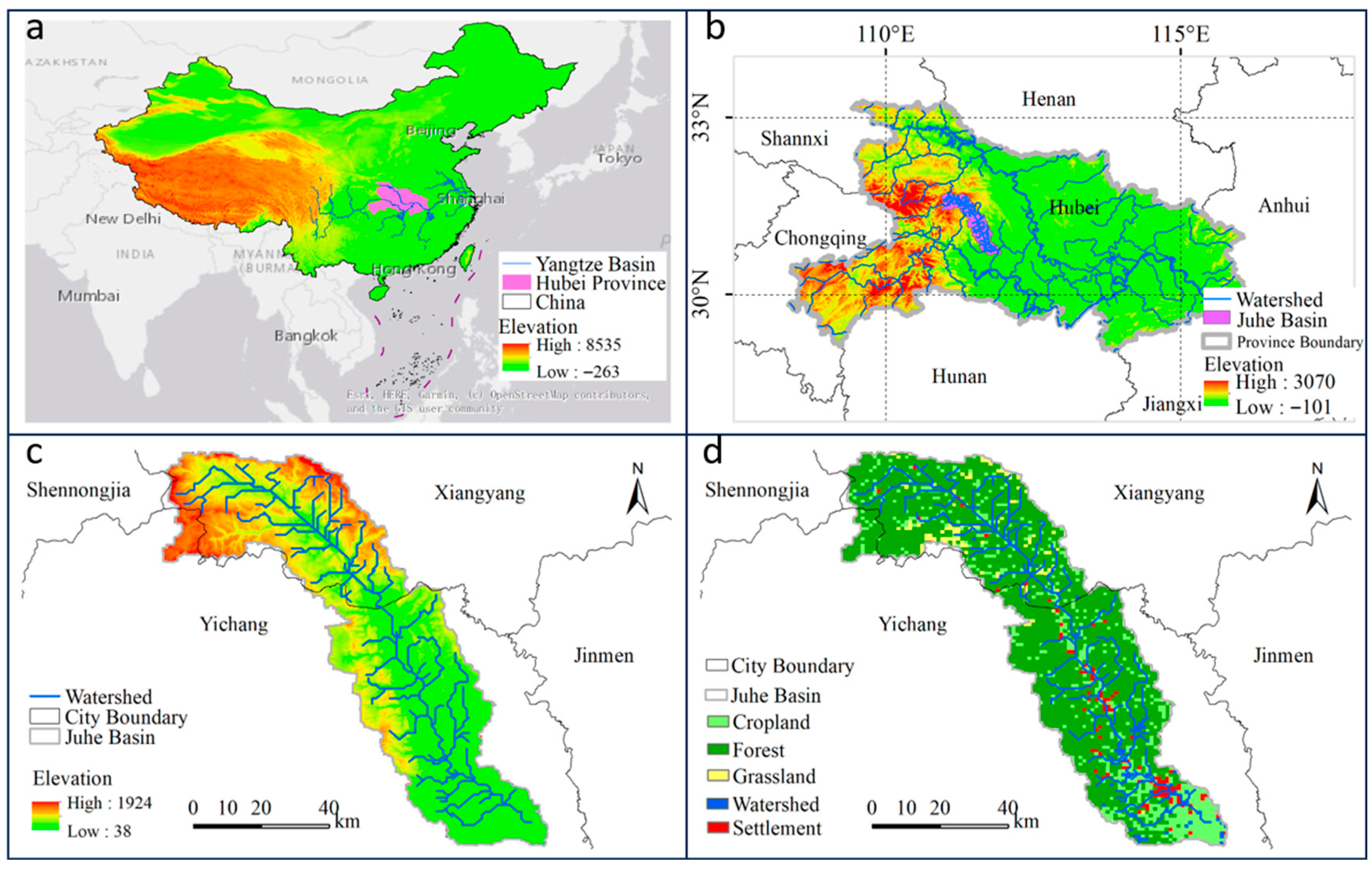
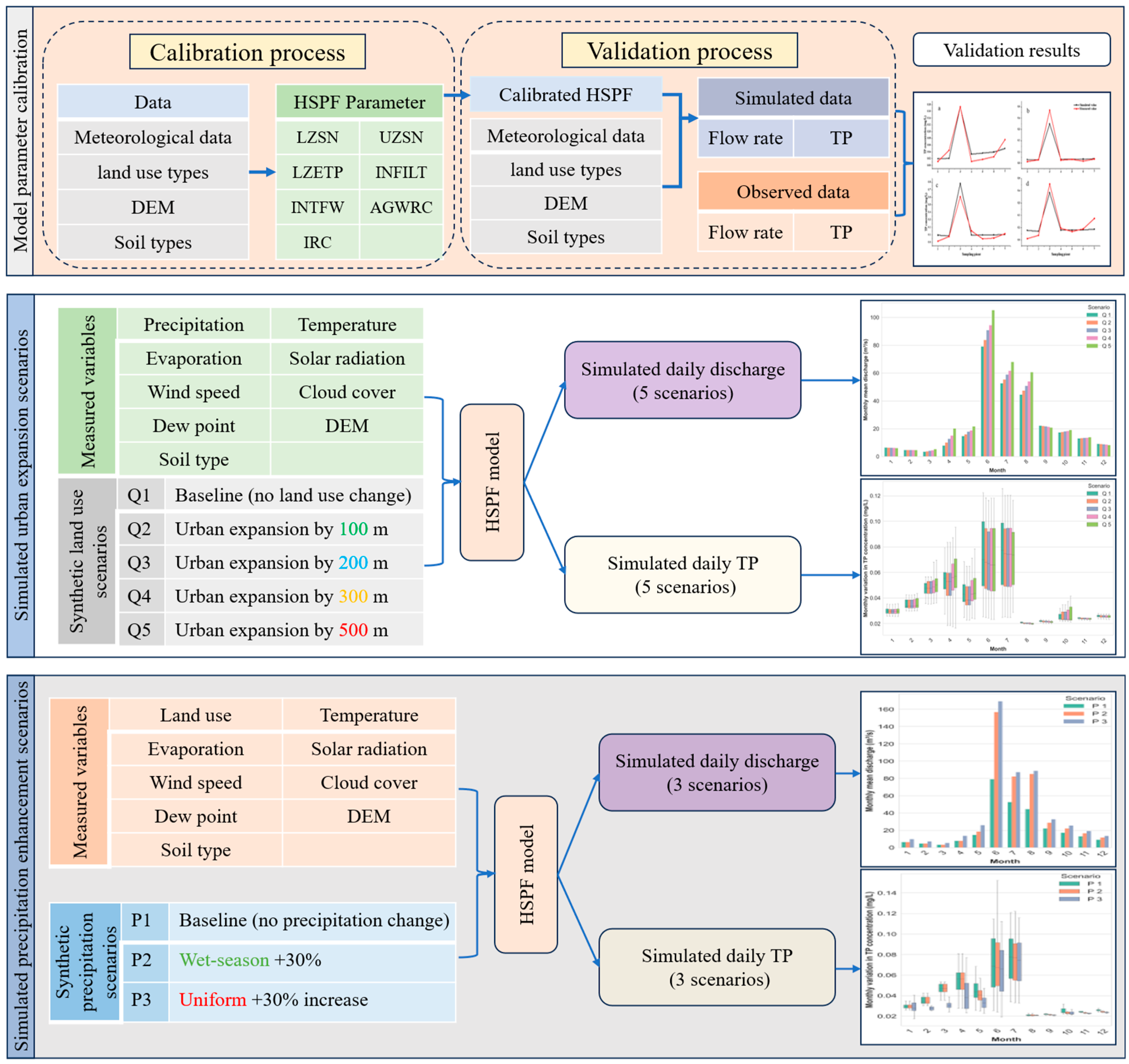

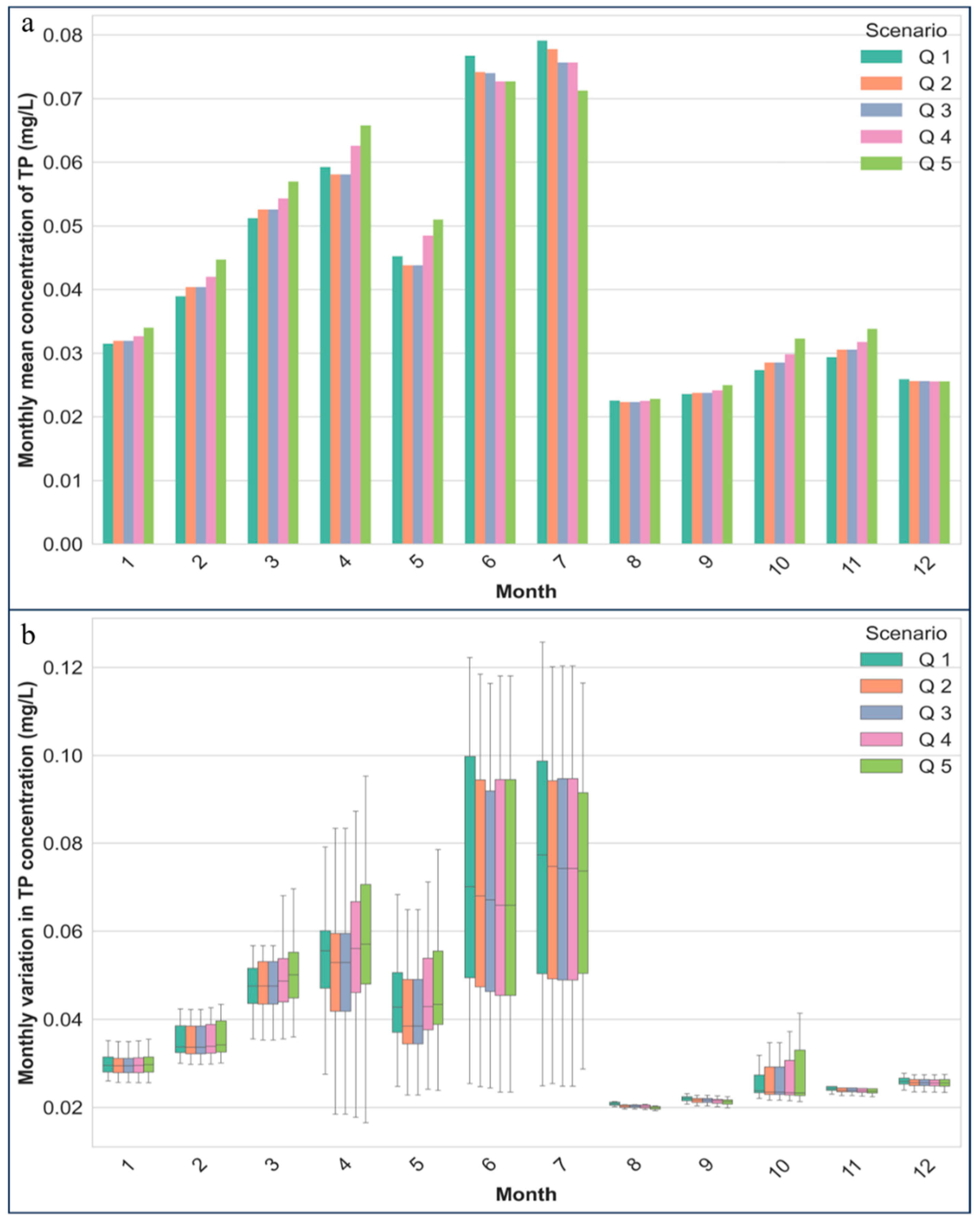
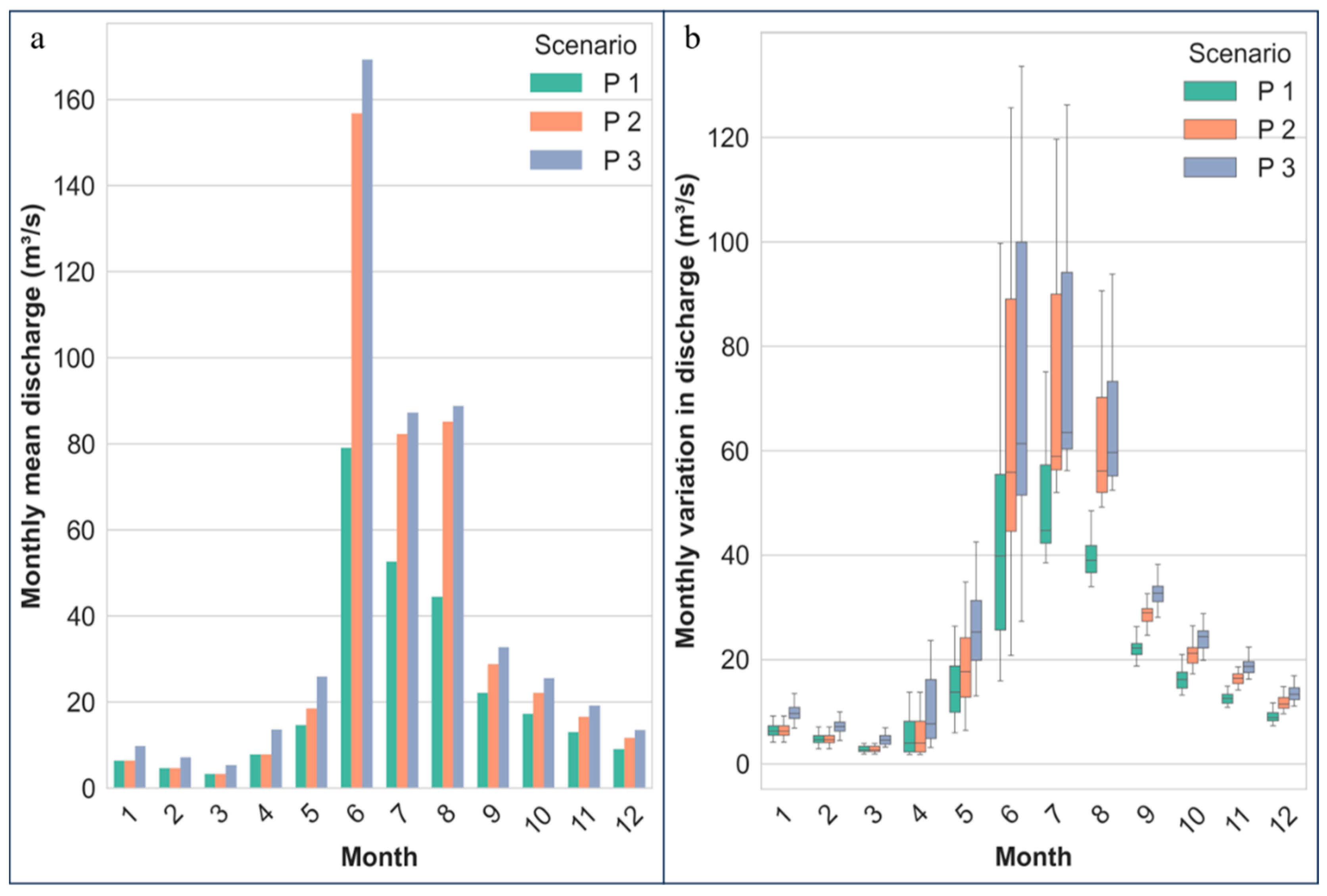
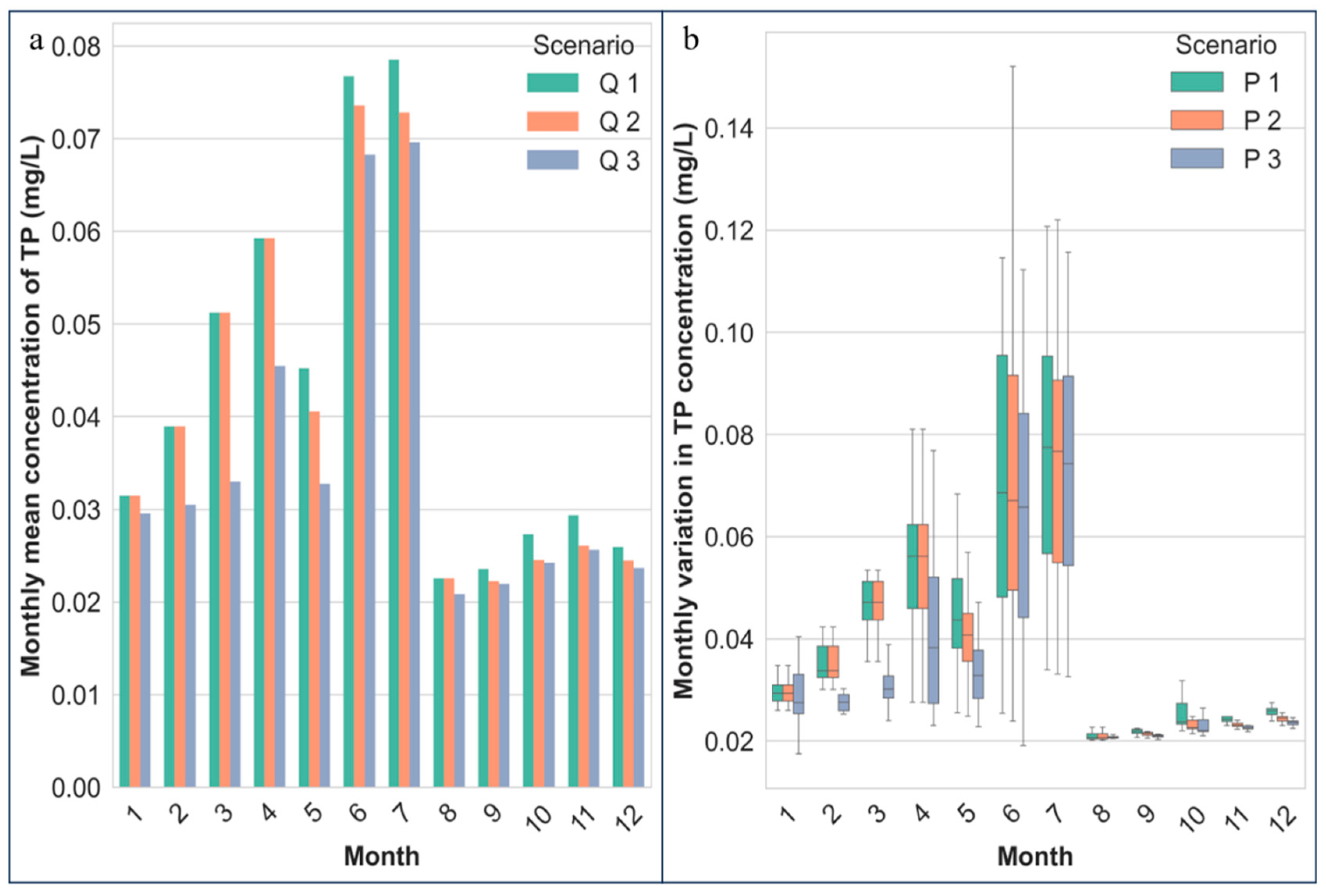
| Data | Format | Resolution | Year | Source |
|---|---|---|---|---|
| DEM | img | 30 m | 2022 | https://www.resdc.cn/data.aspx?DATAID=217 (accessed on 18 July 2022) |
| Land Use | tiff | 1 km | 2023 | https://www.resdc.cn/DOI/DOI.aspx?DOIid=54 (accessed on 21 June 2022) |
| Hydrological Data | wdm | month | 2022–2023 | Herong Hydrological Station (30.62° N, 112.07° E) |
| Meteorological Data | wdm | 1 h | 2022–2023 | https://data.cma.cn/ (accessed on 23 June 2022) |
| Soil Type | tif | 1 km | 1995 | https://www.resdc.cn/data.aspx?DATAID=145 (accessed on 29 June 2022) |
| Pollution Source | shp | - | 2022 | Yichang municipal bureau of ecology and environment |
| Parameters | Implication | Unit | Values |
|---|---|---|---|
| LZSN | Lower zone nominal storage | In | 3.5 |
| UZSN | upper zone nominal storage | In | 1 |
| LZETP | lower zone E-T parameter | None | 0.1 |
| INFILT | infiltration rate | In/hr | 0.25 |
| INTFW | interflow inflow parameter | Non | 0.75 |
| AGWRC | groundwater recession constant | 1/day | 0.99 |
| IRC | interflow recession constant | 1/day | 0.5 |
| Date | Type | Re | R2 | NSE |
|---|---|---|---|---|
| 12 January 2022 | Flow rate (m3/s) | −3.4% | 0.87 | 0.75 |
| 8 January 2023 | Flow rate (m3/s) | 1.4% | 0.98 | 0.96 |
| 14 July 2022 | TP (mg/L) | −7.28% | 0.98 | 0.86 |
| 24 February 2023 | TP (mg/L) | 7.4% | 0.94 | 0.89 |
| 12 May 2023 | TP (mg/L) | −8.65% | 0.99 | 0.91 |
| 5 July 2023 | TP (mg/L) | 17.46% | 0.98 | 0.82 |
| Month | P1 | P2 | P3 | P4 | P5 | Q1 | Q2 | Q3 |
|---|---|---|---|---|---|---|---|---|
| January | 543.66 | 555.15 | 555.50 | 573.48 | 614.70 | 543.66 | 543.66 | 785.74 |
| February | 443.43 | 470.96 | 480.91 | 514.43 | 582.73 | 443.43 | 443.43 | 526.58 |
| March | 496.74 | 590.42 | 678.35 | 796.32 | 1036.63 | 496.74 | 496.74 | 468.43 |
| April | 977.95 | 1202.93 | 1510.01 | 1864.09 | 2608.28 | 977.95 | 977.95 | 1552.04 |
| May | 1787.63 | 1953.17 | 2234.10 | 2638.77 | 3340.07 | 1787.63 | 1977.21 | 2205.99 |
| June | 18,647.37 | 18,600.02 | 19,830.16 | 20,913.83 | 23,250.19 | 18,647.37 | 29,749.57 | 30,919.88 |
| July | 11,777.29 | 13,351.91 | 12,996.36 | 13,621.02 | 13,250.08 | 11,777.29 | 17,619.89 | 17,504.90 |
| August | 2838.41 | 3039.71 | 3330.35 | 3601.78 | 4136.67 | 2838.41 | 5832.50 | 5187.54 |
| September | 1355.55 | 1361.94 | 1354.63 | 1370.09 | 1411.65 | 1355.55 | 1657.69 | 1868.15 |
| October | 1334.07 | 1465.05 | 1536.83 | 1695.09 | 2022.72 | 1334.07 | 1500.93 | 1695.78 |
| November | 1042.19 | 1147.26 | 1207.01 | 1339.43 | 1623.66 | 1042.19 | 1152.26 | 1307.60 |
| December | 624.88 | 605.81 | 595.10 | 580.21 | 555.48 | 624.88 | 763.67 | 851.86 |
Disclaimer/Publisher’s Note: The statements, opinions and data contained in all publications are solely those of the individual author(s) and contributor(s) and not of MDPI and/or the editor(s). MDPI and/or the editor(s) disclaim responsibility for any injury to people or property resulting from any ideas, methods, instructions or products referred to in the content. |
© 2025 by the authors. Licensee MDPI, Basel, Switzerland. This article is an open access article distributed under the terms and conditions of the Creative Commons Attribution (CC BY) license (https://creativecommons.org/licenses/by/4.0/).
Share and Cite
Deng, C.; Xiang, Q.; Xiong, Q.; Jiang, S.; Xu, F.; Li, L.; Zhu, J.; Zhou, Y. Phosphorus Loss Risk in the Ju River Basin, China, Under Urbanization and Climate Change: Insights from the Hydrological Simulation Program—FORTRAN (HSPF) Model. Water 2025, 17, 2771. https://doi.org/10.3390/w17182771
Deng C, Xiang Q, Xiong Q, Jiang S, Xu F, Li L, Zhu J, Zhou Y. Phosphorus Loss Risk in the Ju River Basin, China, Under Urbanization and Climate Change: Insights from the Hydrological Simulation Program—FORTRAN (HSPF) Model. Water. 2025; 17(18):2771. https://doi.org/10.3390/w17182771
Chicago/Turabian StyleDeng, Chaozhong, Qian Xiang, Qinxue Xiong, Shunyao Jiang, Fuli Xu, Liman Li, Jianqiang Zhu, and Yuan Zhou. 2025. "Phosphorus Loss Risk in the Ju River Basin, China, Under Urbanization and Climate Change: Insights from the Hydrological Simulation Program—FORTRAN (HSPF) Model" Water 17, no. 18: 2771. https://doi.org/10.3390/w17182771
APA StyleDeng, C., Xiang, Q., Xiong, Q., Jiang, S., Xu, F., Li, L., Zhu, J., & Zhou, Y. (2025). Phosphorus Loss Risk in the Ju River Basin, China, Under Urbanization and Climate Change: Insights from the Hydrological Simulation Program—FORTRAN (HSPF) Model. Water, 17(18), 2771. https://doi.org/10.3390/w17182771











